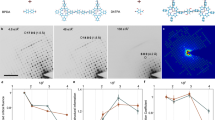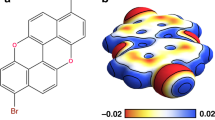Abstract
THE ability to prepare thin films of amphiphilic molecules (Langmuir–Blodgett (LB) films) is valuable to many areas of research. In biology they provide models for ideal membranes; the two-dimensional behaviour and structural phase transitions are of fundamental interest in surface physics; and their tribological characteristics suggest potential engineering applications. For determining the structure of these films, the common techniques such as X-ray and neutron scattering are limited to thick ( ≳200 Å) multilayers. Thinner films can be studied by transmission electron microscopy and low-energy electron diffraction1,2, but these electron-beam techniques tend to damage thin films. More recently, the scanning tunnelling microscope3 has provided a non-destructive means of investigating the structures of LB films4–6, but as the films are insulating, the interpretation of such images has been controversial. The atomic force microscope7 is not plagued with these ambiguities, as it does not require a conductive sample. Here we present images, with molecular resolution, of LB films of cadmium arachidate deposited on an amorphous silicate substrate. Despite the disorder in the substrate, the films display a periodic structure over large distances (several hundreds of ångstroms). This suggests that the adsorbed molecules near the interface are driven to self-assemble primarily, if not solely, by intermolecular forces rather than by dependence on substrate periodicity.
This is a preview of subscription content, access via your institution
Access options
Subscribe to this journal
Receive 51 print issues and online access
$199.00 per year
only $3.90 per issue
Buy this article
- Purchase on Springer Link
- Instant access to full article PDF
Prices may be subject to local taxes which are calculated during checkout
Similar content being viewed by others
References
Vogel, V. & Wöll, C. J. chem. Phys. 84, 5200–5204 (1986).
Garoff, S., Deckmann, H. W., Dunsmuir, J., Alvarez, M. S. & Bloch, J. M. J. Physique 47, 701–709 (1986).
Binnig, G., Rohrer, H. & Gerber, C. Phys. Rev. Lett. 49, 57–61 (1982).
Smith, D. P. E. et al. Proc. natn. Acad. Sci. U.S.A. 84, 969–972 (1987).
Fuchs, H., Schrepp, W. & Rohrer, H. Surf. Sci. 181, 391–393 (1987).
Lang, C. A. Hörber, J. K. H., Hänsch, T. W., Heckl, W. M. & Möhwald, H. J. Vac. Sci. Technol. A6, 368–370 (1989).
Binnig, G., Quate, C. F. & Gerber, C. Phys. Rev. Lett. 56, 930–933 (1986).
Mizutani, W., Shigeno, M. & Kajimura, K. Appl. Phys. Lett. 56, 1974–1976 (1990).
Heinzelmann, H., Meyer, E., Rudin, H., Güntherodt, H.-J. in Scanning Tunneling Microscopy and Related Methods (eds Behm, R. J. et al.) 443–467 (Kluwer Academic, Netherlands, 1990).
McClelland, G. M., Erlandsson, R. & Chiang, S. Rev. Progr. Qual. non-destr. Eval. 6, 1307–1315 (Plenum, New York, 1987).
Rugar, D., Mamin, H. J., Erlandsson, R., Stern, J. E. & Terris, B. D. Rev. Sci. Instrum. 59, 2337–2340 (1988).
Meyer, G. & Amer, N. M. Appl. Phys. Lett. 53, 1045–1047 (1988).
Alexander, S. et al. J. appl. Phys. 65, 164–167 (1989).
Erlandsson, R. McClelland, G. M., Mate, C. M. & Chiang, S. J. Vac. Sci. Technol. A6, 266–270 (1988).
Goddenhenrich, T., Hartmann, U., Lemke, H. & Heiden, C. J. Vac. Sci. Technol. 8, 383–387 (1990).
Meyer, E. et al. Europhys Lett. 9, 695–700 (1989).
Meyer, G. & Amer, N. M. Appl. Phys. Lett. 56, 2100–2101 (1990).
Meyer, E., Heinzelmann, H., Rudin, H. & Güntherodt, H.-J. Z. Phys. B 79, 3–4 (1990).
Marti, O. et al. Science 239, 50–52 (1988).
Schreck, M. et al. Thin Solid Films 175, 95–101 (1989).
Kern, W. RCA Engineer. 28, 99–105 (1983).
Trucks, G. W., Raghavachari, K., Higashi, G. S. & Chabal, Y. J. Phys. Rev. Lett. 65, 504–507 (1990).
Meyer, E. et al. J. Microsc. 152, 269–280 (1988).
Blackman, G. S., Mate, C. M. & Philpott, M. R. Phys. Rev. Lett. 65, 2270–2273 (1990).
Burnham, N. A., Dominguez, D. D., Mowery, R. L. & Colton, R. J. Phys. Rev. Lett. 64, 1931–1934 (1990).
Author information
Authors and Affiliations
Rights and permissions
About this article
Cite this article
Meyer, E., Howald, L., Overney, R. et al. Molecular-resolution images of Langmuir–Blodgett films using atomic force microscopy. Nature 349, 398–400 (1991). https://doi.org/10.1038/349398a0
Received:
Accepted:
Issue Date:
DOI: https://doi.org/10.1038/349398a0
This article is cited by
-
Direct resolution of the pitch of DNA on positively charged lipid bilayers by frequency-modulation AFM
Journal of Shanghai Jiaotong University (Science) (2014)
-
Topography and functional information of plasma membrane
Science in China Series C: Life Sciences (2008)
Comments
By submitting a comment you agree to abide by our Terms and Community Guidelines. If you find something abusive or that does not comply with our terms or guidelines please flag it as inappropriate.



